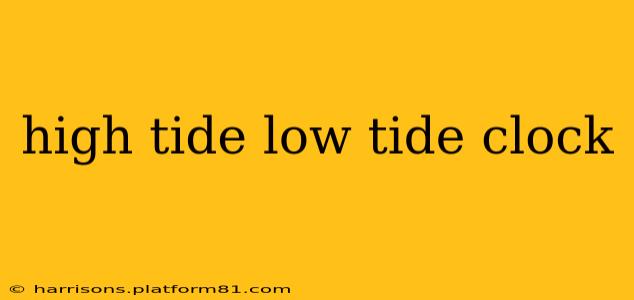The rhythmic ebb and flow of the tides, a mesmerizing dance between the ocean and the moon, has captivated humanity for centuries. For coastal communities, understanding these tidal shifts is crucial for navigation, fishing, and even daily life. A high tide low tide clock offers a convenient and visually appealing way to track these crucial changes, providing a glimpse into the intricate celestial mechanics that govern our oceans. But what exactly is a high tide low tide clock, and how does it work? This comprehensive guide delves into the fascinating world of tidal clocks, exploring their functionality, benefits, and the science behind the tides themselves.
What is a High Tide Low Tide Clock?
A high tide low tide clock is a specialized timepiece that displays the predicted times of high and low tides for a specific location. Unlike a standard clock showing hours and minutes, it features a visual representation of the tidal cycle, often using a dial or digital display to indicate the height and time of high and low tides throughout the day. These clocks are typically calibrated to a particular geographic location, taking into account the complex interplay of gravitational forces from the moon and sun. Some advanced models may even account for variations caused by weather patterns and other influencing factors.
How Does a High Tide Low Tide Clock Work?
The mechanism behind a high tide low tide clock is surprisingly simple, relying on pre-programmed tidal data. The clock utilizes astronomical calculations to determine the expected tidal patterns. This information is usually sourced from tidal prediction tables or sophisticated algorithms that incorporate various astronomical parameters, such as the moon's position, its phase, and the sun's gravitational influence. The resulting data is then translated into a visual representation on the clock's face, accurately depicting the high and low tide times.
What are the Benefits of Using a High Tide Low Tide Clock?
The advantages of using a high tide low tide clock are numerous, especially for individuals whose activities are heavily influenced by the tides:
- Precise Timing: Provides accurate predictions of high and low tides, enabling meticulous planning for activities such as fishing, boating, and coastal exploration.
- Enhanced Safety: Crucial for water-based activities, providing advance warning of high tides to avoid potential flooding or dangerous currents.
- Convenience: Offers a readily accessible and easy-to-understand display of tidal information, eliminating the need to consult complex tidal charts.
- Educational Tool: Serves as a great educational tool for understanding the relationship between the moon, the sun, and the tides.
How Accurate are High Tide Low Tide Clocks?
The accuracy of a high tide low tide clock depends on several factors, including:
- Data Source: Clocks using high-quality, up-to-date tidal prediction data will generally offer better accuracy.
- Location Specificity: The accuracy is higher for locations with well-established tidal data.
- External Factors: Unforeseen weather patterns or other environmental changes can sometimes affect tidal predictions and reduce accuracy.
Generally, high-quality clocks provide reasonably accurate predictions, within a margin of error that’s acceptable for most applications.
Where Can I Find a High Tide Low Tide Clock?
High tide low tide clocks can be found through various online retailers specializing in nautical instruments or weather forecasting tools. You may also find them in specialty shops that cater to coastal communities or boating enthusiasts. When selecting a clock, consider the accuracy, features, and design to find one that suits your specific needs and preferences.
What are the Different Types of High Tide Low Tide Clocks?
High tide low tide clocks come in various designs and functionalities:
- Analog Clocks: Traditional clock faces with pointers indicating high and low tide times.
- Digital Clocks: Display tidal information digitally, often with additional features such as date and temperature.
- Combination Clocks: Combine analog and digital displays, offering a comprehensive view of tidal information.
The choice between these types depends on personal preference and desired features.
Do I need a specific location for my high tide low tide clock?
Yes, absolutely! High tide low tide clocks are calibrated for specific geographic locations. The tidal patterns vary significantly depending on your location due to variations in the coastline's shape, the ocean's depth, and other geographic factors. Therefore, a clock designed for one location won't accurately reflect the tides in another. Ensure you select a clock specifically programmed for your area of interest.
How often do I need to update my high tide low tide clock?
Most high tide low tide clocks don't require regular updates. The tidal data is usually pre-programmed based on astronomical calculations that are relatively consistent over time. However, some advanced models might offer update functionality to incorporate the latest data and improve prediction accuracy. Check your clock's manual for specific update instructions if available.
By understanding the workings and benefits of a high tide low tide clock, you can harness the power of this useful tool to better navigate and understand the rhythmic pulse of our oceans. Whether you're an avid sailor, a dedicated fisher, or simply fascinated by the wonders of the natural world, a high tide low tide clock offers an invaluable window into the captivating world of tides.
